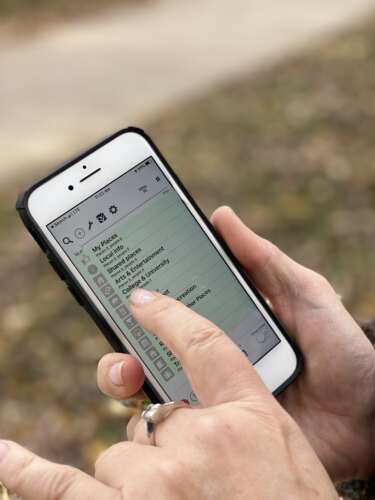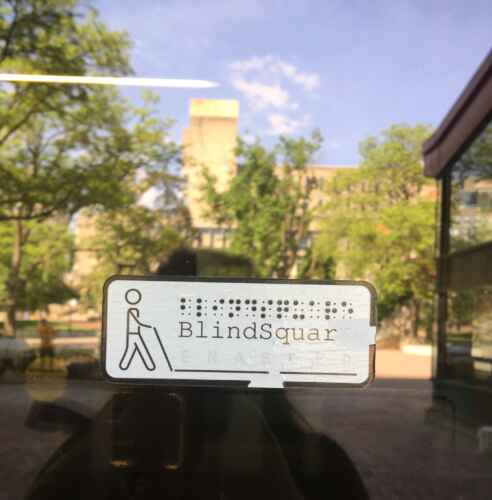An electronic wayfinding system on the University of Guelph campus designed to help blind and visually impaired people navigate their way around campus continues to expand.
U of G was the first Canadian post-secondary campus to install an indoor and outdoor electronic wayfinding system in 2018.
Called BlindSquare, the system relies on a network of wall-mounted beacons whose low-energy signals are picked up by the devices of users who have downloaded the BlindSquare app. The app then provides audio voicing to help users understand their surroundings and provide them with directions and important information.
Introduced initially in high-traffic buildings, there are now 400 GPS-enabled BlindSquare service points on campus including at the entrances to all buildings.
“We are proud to be leading this initiative as the first Canadian post-secondary institution with this complete system,” said Jill Vigers, manager of architectural services with Physical Resources.
System combines GPS, Bluetooth beacons and QR codes

When BlindSquare users enter the beacon coverage zone – which comprises a 10-kilometre radius covering the main campus, the U of G Arboretum and much of downtown Guelph – the system begins to talk to the user to alert them of the locations of corridors, elevators, stairways and campus landmarks.
When the GPS satellite fails indoors, the system becomes dependent on Bluetooth signals that are battery-operated. Eighty per cent of buildings on U of G’s campus have this service.
QR codes provide additional information about specific locations, such as telling a user that one elevator bank takes visitors to upper-floor classrooms while another bank does not. They are in the J.T. Powell Building, the Mitchell Centre, all single-use gender-neutral washrooms and campus map totems.
“Several American universities have installed partial electronic wayfinding systems, but not all three components: outdoor GPS, Bluetooth beacons and QR codes,” said Vigers.
By providing students with multiple layers of information about where they are while confirming their location, BlindSquare provides more convenient information about immediate surroundings than Braille signs can, and the information can continually be kept current.
Another tool to aid in wayfinding

The BlindSquare app does not replace the skills of a cane and/or heightened use of sense of hearing. Instead, the app becomes another tool to aid in wayfinding and for learning additional information about the spaces and history on campus.
Vigers helped launch the campus BlindSquare project after hearing about wayfinding systems during an accessibility conference in 2016. She was already working on a campus-wide wayfinding and signage upgrade for pedestrians and visitors and helped incorporate a system for people with visual impairments.
The Guelph Lions Club provided $48,000 in funding over four years to extend the BlindSquare system across campus.
With U-R-Able and Key2Access, the service group has committed to an additional initiative that would see “smart” speakers installed on electric utility vehicles. That initiative is currently in its test phase and would tell BlindSquare users about whether the vehicle is parked or running and warn of its location.
“We’re committed to expanding, maintaining and keeping the system relevant, and are thankful for the Guelph Lions Club’s support,” said Vigers.
Contact:
Jill Vigers
jill@pr.uoguelph.ca
